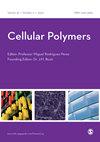钠蒙脱土纳米粘土对棕榈油基硬质水吹聚氨酯泡沫材料的可燃性、热稳定性、形态和力学性能的影响
IF 1.3
4区 医学
Q4 MATERIALS SCIENCE, BIOMATERIALS
引用次数: 0
摘要
本文介绍了用钠蒙脱土(Na-MMT)增强棕榈油基聚氨酯(PU)刚性泡沫的实验研究。填料的装载量在1 - 10 wt %之间变化。所得泡沫的可燃性、形态、热稳定性和力学响应进行了表征。在较低的Na-MMT加载下,粘土的微观结构呈现出剥离。在聚氨酯泡沫中添加纳米粘土并没有给其可燃性带来任何明显的改善,这可能是由于所使用的低功能棕榈油多元醇的影响更大。在低粘土量下观察到热稳定性的明显改善。在Na-MMT存在的情况下,泡沫具有更细的孔尺寸,但只有在一定的载荷限制下才能得到。抗压强度一般随粘土含量的增加而增加,但超过3wt %后性能变差。特别的是,抗压强度在5 wt %和6 wt %时再次上升(假设是由于“整体表皮”的额外承重作用),然后再次下降到超过这个值。本文章由计算机程序翻译,如有差异,请以英文原文为准。
Influence of sodium-montmorillonite nanoclay on flammability, thermal stability, morphology, and mechanical properties of rigid water-blown palm oil-based polyurethane foam
This paper presents the experimental works on rigid palm oil-based polyurethane (PU) foam reinforced with sodium-montmorillonite (Na-MMT). Filler loading was varied between 1 and 10 wt %., and the obtained foam was characterized for its combustibility, morphology, thermal stability, and mechanical response. Exfoliated clay microstructure was exhibited at lower Na-MMT loadings. Addition of nanoclay into the PU foam failed to impart any discernable improvement with regards to its flammability, believed due to stronger influence of low-functionality palm oil polyol used. Apparent improvement in thermal stability was observed at low clay amounts. Foam with finer cell size was obtained in the presence of Na-MMT, however only until a certain loading limit. Compressive strength generally increases with increasing clay content, but after 3 wt % the property deteriorated. Peculiarly, compressive strength rose again at 5 wt % and 6 wt % – postulated due to additional load-bearing effect of ‘integral skin’ – before plummeting back again beyond this value.
求助全文
通过发布文献求助,成功后即可免费获取论文全文。
去求助
来源期刊

Cellular Polymers
工程技术-材料科学:生物材料
CiteScore
3.10
自引率
0.00%
发文量
9
审稿时长
3 months
期刊介绍:
Cellular Polymers is concerned primarily with the science of foamed materials, the technology and state of the art for processing and fabricating, the engineering techniques and principles of the machines used to produce them economically, and their applications in varied and wide ranging uses where they are making an increasingly valuable contribution.
Potential problems for the industry are also covered, including fire performance of materials, CFC-replacement technology, recycling and environmental legislation. Reviews of technical and commercial advances in the manufacturing and application technologies are also included.
Cellular Polymers covers these and other related topics and also pays particular attention to the ways in which the science and technology of cellular polymers is being developed throughout the world.
 求助内容:
求助内容: 应助结果提醒方式:
应助结果提醒方式:


